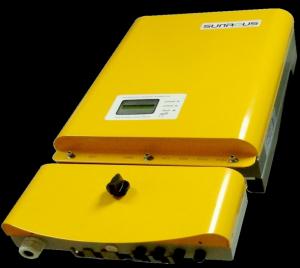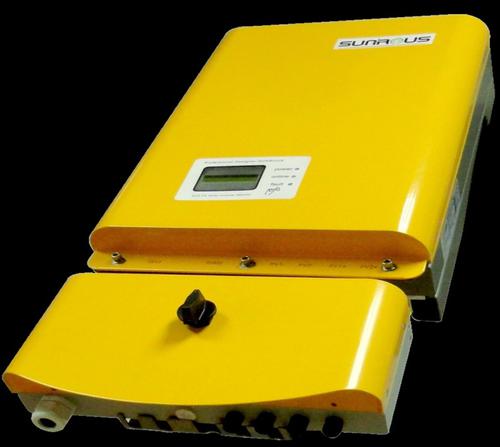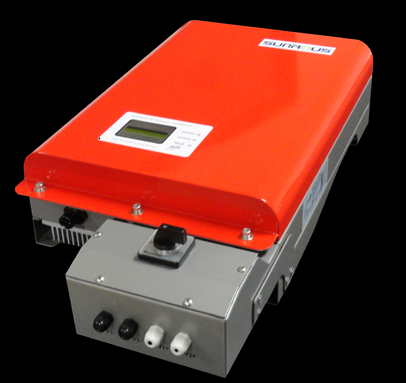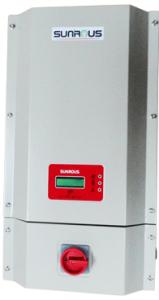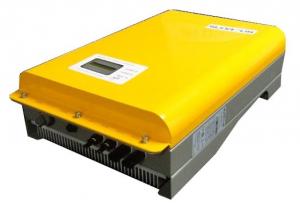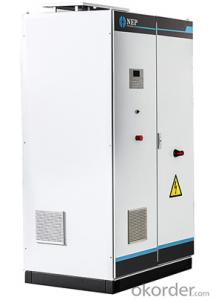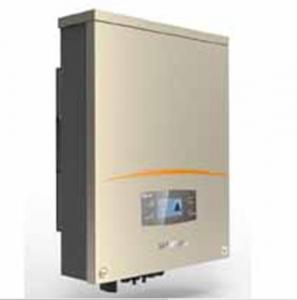Emp Hardened Solar Inverter - PV Grid-Tied Inverter US ETL Certificate
- Loading Port:
- Shanghai
- Payment Terms:
- TT or LC
- Min Order Qty:
- 20 pc
- Supply Capability:
- 1000 pc/month
OKorder Service Pledge
OKorder Financial Service
You Might Also Like
PV Grid-Tied Inverter-US ETL Certificate
5 years warranty
· Sealing stainless steel shell, suitable for indoor or outdoor installation
· High frequency transformer isolation
· The highest effciency achieves 98%
· Wide input Voltage range
· Adopt connectors type cable connection, Easy operation and installation
· Best tracking effciency with OptiTrac MPP control
· operating temperature range -25 ℃ to + 55℃
· High reliability due to complete protection function
· Anti-theft protection
· Plug-in grounding
HF series 1.5kw — 5.0kw
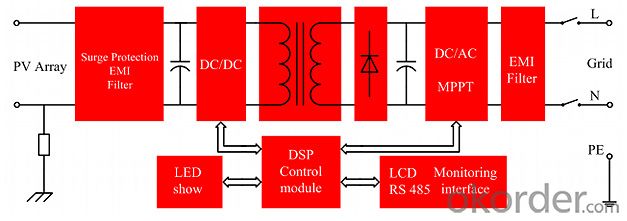
High frequency transformer isolation is the main feature of our production, which make Installation easier due to the reduced weight and higher conversion effciency because of omitting Low frequency transformer. The wide input voltage range from 180 to 600volt gives you extraordinary fexibility for you system design. Not need to set graphic display and RS485 communication system make the devices highly user-friendly.
This product can by multi-level parallel combination for 6kw to 20kw needed any power grade HF series technical parameter.
parameters
GT1.5-ZX-01/HF | GT2.0-ZX-01/HF | GT2.5-ZX-01/HF | GT3.0-ZX-01/HF | GT4.0-ZX-01/HF | GT5.0-ZX-01/HF | |
Input(DC) | ||||||
Max.DC Power | 1600W | 2100W | 2650W | 3150W | 4200W | 5200W |
Max.DC Voltage | 600V | |||||
PV Voltage range, MPPT | 150V ~ 550V | 150V ~ 550V | ||||
Max.input current | 10.0A | 14.0A | 16.0A | 20.0A | 25.0A | 30.0A |
Number of MPP trackers | 1 | |||||
Max.number of strings (parallel) | 1 | 1 | 2 | 2 | 3 | 3 |
Output(AC) | ||||||
Nominal AC power / | 1500W | 2000W | 2500W | 3000W | 4000W | 5000W |
Max.output current | 13.0A/7.0A | 17.0A/9.0A | 21.0A/12.0A | 25.0A/14.0A | 21.0A | 30.0A |
Nominal AC Voltage / range | 102-138Vac/180-264Vac | 180-270Vac | ||||
AC grid frequency / range | 47.5-51.5Hz / 59.3-60.5Hz | |||||
Power factor at rated power | 1 | |||||
THD | < 3% | |||||
AC connection | Single-phase | |||||
Efficiency | ||||||
Max. efficiency/Californian efficiency | > 98.0% / > 97.0% | |||||
MPP adaptation efficiency | > 99.0% | |||||
Protection devices | ||||||
DC reverse polarity protection | √ | |||||
AC short-circuit protection | √ | |||||
Ground fault monitoring | √ | |||||
Grid monitoring | √ | |||||
Output Transient Voltage Suppression | √ | |||||
Over load | √ | |||||
Anti-islanding | √ | |||||
General data | ||||||
Dimensions (W/ H / D) in mm | 350 / 560 / 160 | 370 / 540 / 185 | ||||
Weight(Kg) | 16 | 19 | 23 | |||
Operating temperature range | -25 ~ +60℃ | |||||
Storage temperature range | -40 ~ +70℃ | |||||
Ambient humidity | 0 ~ 100% | |||||
Consumption (night) | < 0.5W | |||||
Topology | HF-transformer galvanic isolation | |||||
Cooling concept | Convection | |||||
Enclosure type | IP65 / NEMA 3R | |||||
Features | ||||||
DC connection: PV special connector | √ | |||||
AC connection: connector | √ | |||||
LCD display & Backlit | √ | |||||
LED display | √ | |||||
Interfaces: RS485 | √ | |||||
Warranty: 10 years | √ | |||||
Certificates & approvals | G83 / G59 / TUV / SAA / ETL / JET/ CE | |||||
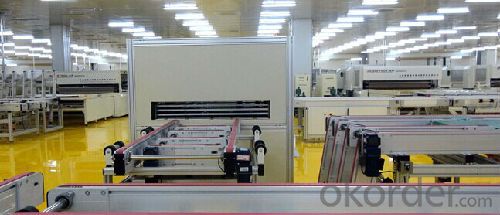
- Q: How does a solar inverter handle power factor correction?
- A solar inverter handles power factor correction by continuously monitoring the power factor of the electrical load and adjusting its operation accordingly. It applies various control techniques to ensure that the power factor is maintained close to unity, ultimately improving the efficiency and stability of the solar power system.
- Q: What is the maximum power output of a residential solar inverter?
- The maximum power output of a residential solar inverter typically ranges from 1 kilowatt (kW) to 10 kW, depending on the specific model and capacity of the system.
- Q: What is the maximum AC output current that a solar inverter can provide?
- The maximum AC output current that a solar inverter can provide depends on its specifications and capacity. Different models and brands may have varying maximum AC output current ratings, typically ranging from a few amps to several hundred amps. It is important to consult the specific technical specifications of a particular solar inverter to determine its maximum AC output current capacity.
- Q: Can a solar inverter be connected to a home automation system?
- Yes, a solar inverter can be connected to a home automation system. This integration allows for better control and monitoring of the solar energy production and enables homeowners to optimize their energy usage based on real-time data.
- Q: PV grid-connected inverter and independent inverter in the control of what is the difference
- PV grid-connected inverter in the grid before the inverter needs to determine the phase voltage phase frequency, the first phase-locked, in the grid and power generation.
- Q: Can a solar inverter be used with different types of power conditioning units?
- Yes, a solar inverter can be used with different types of power conditioning units. Solar inverters are designed to convert the DC power generated by solar panels into AC power that can be used by various electrical devices. They can be compatible with different types of power conditioning units, such as battery storage systems or grid-tied inverters, depending on the specific requirements and setup of the solar power system.
- Q: Can a solar inverter be used with building-integrated photovoltaics (BIPV)?
- Yes, a solar inverter can be used with building-integrated photovoltaics (BIPV). BIPV systems are designed to seamlessly integrate solar panels into the building structure, providing both energy generation and architectural functionality. Solar inverters play a crucial role in BIPV systems by converting the direct current (DC) produced by the solar panels into alternating current (AC) that can be used to power electrical devices in the building or fed back into the grid.
- Q: What is the role of ground fault protection in a solar inverter?
- The role of ground fault protection in a solar inverter is to detect and respond to any faults or abnormalities in the electrical system, specifically related to the grounding of the system. It ensures the safety of the inverter, the solar panels, and the overall electrical system by interrupting the flow of current in the event of a ground fault, preventing potential electric shock hazards and damage to the equipment.
- Q: What is the role of a voltage control unit in a solar inverter?
- The role of a voltage control unit in a solar inverter is to regulate and stabilize the voltage output from the solar panels, ensuring that it matches the required voltage for the connected electrical devices or grid connection. This unit helps to maximize the efficiency of the solar inverter and prevent any potential damage to the electrical system by maintaining a consistent and optimal voltage level.
- Q: What is the role of isolation in a solar inverter?
- The role of isolation in a solar inverter is to provide safety and protection by electrically separating the DC input side (solar panels) from the AC output side (grid or load) to prevent any potential hazards such as electrical shocks, short circuits, or ground faults. It also helps in reducing noise interference and improving the overall performance and efficiency of the inverter.
Send your message to us
Emp Hardened Solar Inverter - PV Grid-Tied Inverter US ETL Certificate
- Loading Port:
- Shanghai
- Payment Terms:
- TT or LC
- Min Order Qty:
- 20 pc
- Supply Capability:
- 1000 pc/month
OKorder Service Pledge
OKorder Financial Service
Similar products
Hot products
Hot Searches
Related keywords
